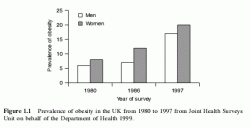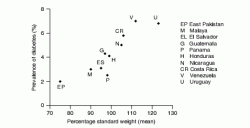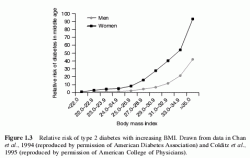The epidemiological link between obesity and diabetes
The link between obesity prevalence and rates of diabetes in different populations was demonstrated by West with an increase in the prevalence of type 2 diabetes as the population becomes more obese (West, 1978; Figure 1.2). Whilst there are changes in the incidence of type 1 diabetes, it is type 2 diabetes that is largely responsible for the global epidemic of diabetes.
Within populations there is clear evidence of a strongly positive relationship between obesity and the risk of diabetes. Data in the United States from the Health Professionals’ Follow-up Study in men (Chan et al., 1994) and the Nurses’ Health Study in women (Colditz et al., 1995) graphically illustrates the increasing risk of diabetes that obesity brings (Figure 1.3). Compared with those of a BMI less than 21, women with a BMI greater than 35 had a 93-fold excess risk of developing diabetes. The risk of developing type 2 diabetes rises progressively with increasing adiposity (whether assessed by BMI, or percentage of ideal body weight).
 Figure 1.1 Prevalence of obesity in the UK from 1980 to 1997 from Joint Health Surveys Unit on behalf of the Department of Health 1999.
Figure 1.1 Prevalence of obesity in the UK from 1980 to 1997 from Joint Health Surveys Unit on behalf of the Department of Health 1999.
Data from NHANES shows that for each kilogram increase in weight of the population the risk of diabetes increases by 4.5 per cent (Ford et al., 1997). Figure 1.2 Graph showing the relationship between the prevalence of diabetes (predominantly type 2 diabetes) and body weight in 10 representative populations. Body weight is expressed as the population mean, relative to a ‘standard’ weight that is given an arbitrary score of 100. Reproduced from West 1978 by permission of Elsevier Science.
Figure 1.2 Graph showing the relationship between the prevalence of diabetes (predominantly type 2 diabetes) and body weight in 10 representative populations. Body weight is expressed as the population mean, relative to a ‘standard’ weight that is given an arbitrary score of 100. Reproduced from West 1978 by permission of Elsevier Science.
More recent examination of diabetes trends in the US showed an even steeper increment of diabetes risk with weight gain, with a 9 per cent increased risk of diabetes for each kilogram of body weight gain (Mokdad et al., 2000). Whether this large difference is a real phenomenon, or is explained by increased public awareness of diabetes is not clear, as the later study depended on telephone surveys.
Where populations have changed their lifestyle and become more obese (e.g. Pima Indians of Arizona, Micronesian Nauruan Islanders) an epidemic of type 2 diabetes has followed on. Groups that were previously lean and had a low incidence of diabetes have become obese diabetics. 80 per cent of adult Pima Indians are now obese and 40 per cent of this population now has type 2 diabetes (Zimmet, 1982). In comparison, a genetically almost identical Pima Indian population in Mexico has been described who are lean and whose incidence of type 2 diabetes is virtually zero (Ravussin et al., 1994; Esparza et al., 2000). The importance of obesity in the development of diabetes is clearly demonstrated.
 Figure 1.3 Relative risk of type 2 diabetes with increasing BMI. Drawn from data in Chan et al., 1994 (reproduced by permission of American Diabetes Association) and Colditz et al., 1995 (reproduced by permission of American College of Physicians).
Figure 1.3 Relative risk of type 2 diabetes with increasing BMI. Drawn from data in Chan et al., 1994 (reproduced by permission of American Diabetes Association) and Colditz et al., 1995 (reproduced by permission of American College of Physicians).
Amongst patients with type 2 diabetes excess adiposity is almost the rule. In the Diabetic Clinic in Dundee about 80 per cent of patients attending are either overweight or obese (Jung, 1997). Increasing obesity in the general population is now reflected in patients with diabetes. Of those patients newly presenting with diabetes in a clinic in Minnesota in the 1970s 33 per cent were obese, whereas 49 per cent of those diagnosed in the late 1980s were obese (Leibson et al., 2001). Thus, not only are we likely to see more patients with diabetes, but also to see more obese patients amongst our diabetic patients with the additional difficulties that accompany their clinical management.
In tandem with the rise in childhood obesity there is now marked rise in type 2 diabetes in children and adolescents. There has been a 10-fold increase in type 2 diabetes amongst children between 1982 and 1994 in the USA (Pinhas-Hamiel et al., 1996). Diabetes in this age group is clearly linked with obesity, although genetic and environmental factors also play a role with many such subjects having a family history of type 2 diabetes and belonging to minority populations (Fagot-Campagna et al., 2000). In place of type 1 diabetes type 2 diabetes may soon become the more common form of childhood diabetes (Zimmet et al., 2001).
Anthony H. Barnett
Department of Medicine, University of Birmingham and Birmingham Heartlands and Solihull NHS Trust (Teaching), UK
Sudhesh Kumar
Professor of Medicine, Diabetes & Metabolism, Warwick Medical School, University of Warwick, UK